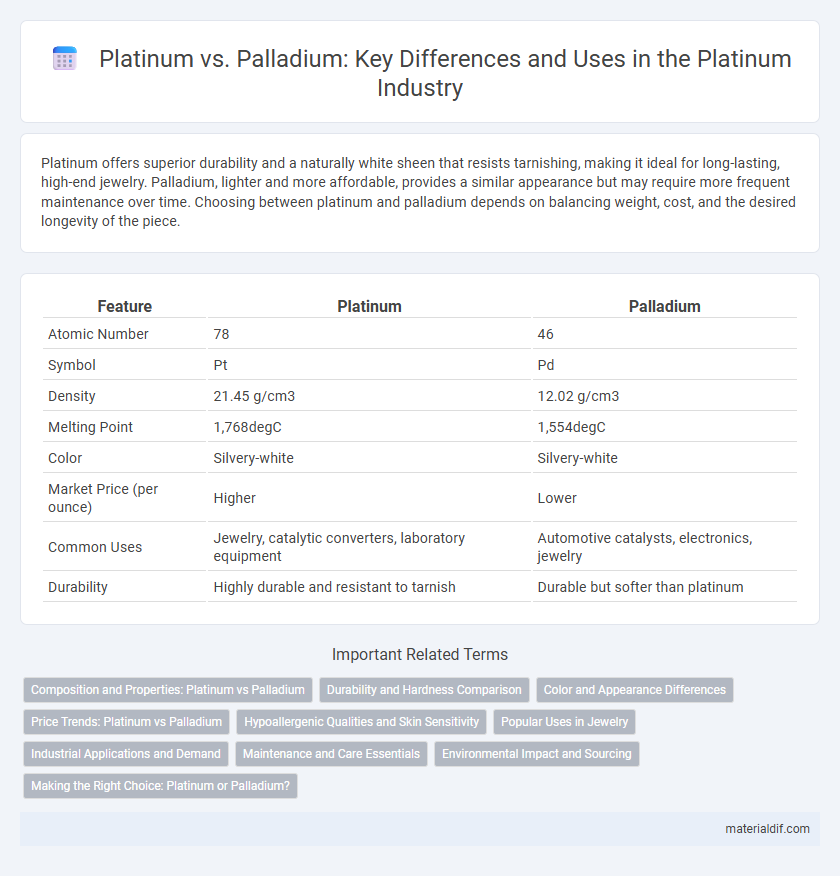Platinum offers superior durability and a naturally white sheen that resists tarnishing, making it ideal for long-lasting, high-end jewelry. Palladium, lighter and more affordable, provides a similar appearance but may require more frequent maintenance over time. Choosing between platinum and palladium depends on balancing weight, cost, and the desired longevity of the piece.
Table of Comparison
| Feature | Platinum | Palladium |
|---|---|---|
| Atomic Number | 78 | 46 |
| Symbol | Pt | Pd |
| Density | 21.45 g/cm3 | 12.02 g/cm3 |
| Melting Point | 1,768degC | 1,554degC |
| Color | Silvery-white | Silvery-white |
| Market Price (per ounce) | Higher | Lower |
| Common Uses | Jewelry, catalytic converters, laboratory equipment | Automotive catalysts, electronics, jewelry |
| Durability | Highly durable and resistant to tarnish | Durable but softer than platinum |
Composition and Properties: Platinum vs Palladium
Platinum is a dense, malleable metal with a high melting point of 1,768degC and excellent corrosion resistance, predominantly composed of pure Pt atoms. Palladium, lighter and with a melting point of 1,555degC, contains Pd atoms arranged in a face-centered cubic structure, offering superior hydrogen absorption capabilities. Both metals exhibit catalytic properties, but platinum's greater chemical stability distinguishes it in applications requiring long-term durability.
Durability and Hardness Comparison
Platinum exhibits superior durability compared to palladium due to its higher density and resistance to wear, making it ideal for everyday jewelry that withstands frequent use. Hardness tests reveal that platinum rates around 4-4.5 on the Mohs scale, while palladium scores slightly lower at about 4, indicating platinum's enhanced ability to resist scratches and deformation. This makes platinum a preferred choice for engagement rings and items requiring long-lasting strength and resilience.
Color and Appearance Differences
Platinum exhibits a naturally white, lustrous sheen that retains its brilliance over time without tarnishing, making it highly desirable for fine jewelry. Palladium, while also white, has a slightly darker, grayer tone and a less reflective surface compared to platinum. The subtle color variation and higher density of platinum contribute to its distinctive, enduring appearance compared to palladium's lighter and more matte finish.
Price Trends: Platinum vs Palladium
Platinum and palladium prices exhibit distinct trends influenced by supply-demand dynamics and industrial applications. While platinum often trades at a premium in times of economic uncertainty due to its rarity and use in catalytic converters for diesel engines, palladium prices have surged recently, largely driven by increased gasoline vehicle catalyst demand and tighter supply. Historical price data shows palladium outperforming platinum since 2017, with palladium's average price reaching over $2,000 per ounce compared to platinum's $1,000-$1,200 range during the same period.
Hypoallergenic Qualities and Skin Sensitivity
Platinum is highly valued for its hypoallergenic properties, making it an excellent choice for individuals with sensitive skin or metal allergies, as it rarely causes allergic reactions. Palladium, while also considered a hypoallergenic metal, can sometimes cause mild skin irritation in people with extreme metal sensitivities due to trace metal impurities or alloys used. For those prioritizing skin safety and minimizing allergic responses, platinum offers a purer and more reliable option in jewelry and medical applications.
Popular Uses in Jewelry
Platinum is favored in jewelry for its durability, naturally white luster, and hypoallergenic properties, making it ideal for engagement rings and luxury pieces. Palladium, part of the platinum group metals, offers a lighter alternative while maintaining a bright finish and resistance to tarnish, appealing to contemporary and budget-conscious buyers. Both metals are valued for their ability to securely hold gemstones and their resistance to wear, but platinum's density and rarity often position it as a premium choice.
Industrial Applications and Demand
Platinum and palladium both play crucial roles in industrial applications, particularly in automotive catalytic converters where platinum is prized for its durability and effectiveness at high temperatures, while palladium is favored for its cost-efficiency and superior catalytic properties in gasoline engines. Industrial demand for platinum is driven by its use in chemical processing, electronics, and fuel cells, whereas palladium experiences higher demand in automotive manufacturing and electronics due to its lower price and similar catalytic efficiency. Market trends indicate shifting preferences based on price fluctuations and technological advancements, with palladium often surpassing platinum in volume but platinum maintaining a critical edge in specialized industrial applications.
Maintenance and Care Essentials
Platinum requires minimal maintenance due to its dense, durable nature, resisting tarnish and scratches more effectively than palladium. Palladium, while also low-maintenance and hypoallergenic, may demand more frequent polishing to preserve its natural luster over time. Both metals benefit from regular cleaning with mild soap and water, but platinum's superior hardness makes it ideal for daily wear with less worry about deformation or damage.
Environmental Impact and Sourcing
Platinum mining generally has a higher environmental impact than palladium due to deeper under-earth extraction processes that consume more energy and water. Palladium often benefits from being a byproduct of nickel and platinum group metal mining, reducing the need for additional mining operations. Sustainable sourcing efforts in the platinum industry are increasing, with stricter regulations and improved recycling practices aimed at lowering its ecological footprint.
Making the Right Choice: Platinum or Palladium?
Platinum offers exceptional durability and a naturally white luster, making it ideal for high-end jewelry that resists tarnishing over time. Palladium, lighter and more affordable than platinum, provides a similar white metal appearance but may require more frequent maintenance. Choosing between platinum and palladium depends on balancing budget constraints with desired longevity and wear resistance for your specific needs.
Platinum vs Palladium Infographic

 materialdif.com
materialdif.com